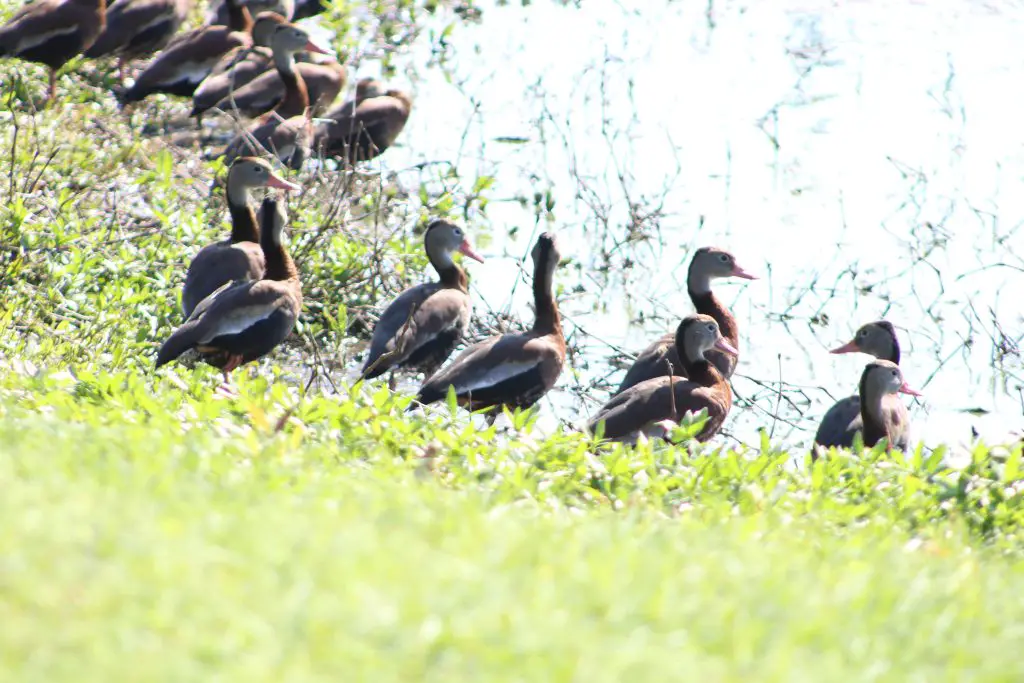If you spot a bunch of ducks, you might wonder what a group of ducks is called. The right term varies based on what the ducks are doing. Some ducks are called a raft, others a flight. And, of course, you can always call any group of birds, including ducks, a flock.
This guide answers the question: What is a bunch of ducks called?
Terms for a group of ducks

The right term for a group of ducks varies based on the situation. Use the round-up below to find out when to call a bunch of ducks what:
- Flock of ducks: The most common term for a group of ducks, typically used when they are flying or foraging together.
- Raft of ducks: Refers specifically to a group of ducks floating together on the water, often resting or feeding.
- Paddling of ducks: Used when describing a group of ducks swimming together, gracefully moving across the water.
- Brace of ducks: An old hunting term used to describe a pair of ducks, often referring to those caught or shot.
- Team of ducks: Occasionally used to describe a group of ducks in flight, moving in a coordinated manner.
- Badling of ducks: A rare and archaic term for a group of ducks, sometimes used in literary or poetic contexts.
- Skein of ducks: Refers to a group of ducks flying in a V-formation, often during migration.
- Waddle of ducks: A playful or informal term used when describing ducks walking together on land.
When do ducks gather in groups?
Ducks are social birds that frequently form groups, but the timing and purpose of their gatherings vary throughout the year. Their group behavior is influenced by migration, mating, and survival strategies.
- Fall and Winter: During the colder months, ducks often form large flocks to migrate or find food. These flocks offer safety in numbers, making it harder for predators to single out an individual bird. Many species of ducks also gather in mixed-species groups during migration.
- Spring: As breeding season begins, ducks become more territorial and pair off. Male and female pairs temporarily separate from larger groups to establish nesting areas.
- Summer: After the mating season, ducks often form smaller family groups. Hens lead their ducklings, while drakes (males) sometimes gather in bachelor groups. Some species begin molting in summer, making them more vulnerable, so they may stay near larger groups for protection.
Overall, ducks are most likely to be seen in large groups during migration seasons (fall and spring), while the summer and breeding months bring smaller, family-focused gatherings.
Male ducks vs female ducks: Correct terms
When discussing an individual duck, it’s appropriate to call males and females different terms based on their ages. Here’s a breakdown:
- Drake: An adult male duck, typically more colorful and vibrant than the females, especially during mating season.
- Hen: An adult female duck, usually duller in color to help with camouflage while nesting.
- Duckling: A young duck, newly hatched and covered in soft, downy feathers, often seen following the hen.
- Juvenile: A teenage duck that has grown out of its down but hasn’t yet developed full adult plumage.
- Flapper: A young duck, just starting to fly, often used in hunting terminology.
- Broody: A female duck sitting on her eggs, often used to describe hens in nesting mode.
- Molter: A duck in the process of shedding and regrowing feathers, temporarily flightless and vulnerable.
Final Take: What is a bunch of ducks called?
The right term for a bunch of turkeys varies based on the situation. Generally, it’s fine to call a group of ducks a flock. But if you want to get specific, you can use the collective nouns outlined above.
